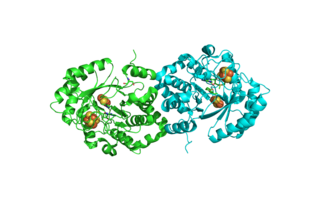Related Research Articles

Proteolysis is the breakdown of proteins into smaller polypeptides or amino acids. Uncatalysed, the hydrolysis of peptide bonds is extremely slow, taking hundreds of years. Proteolysis is typically catalysed by cellular enzymes called proteases, but may also occur by intra-molecular digestion.
A metalloproteinase, or metalloprotease, is any protease enzyme whose catalytic mechanism involves a metal. An example is ADAM12 which plays a significant role in the fusion of muscle cells during embryo development, in a process known as myogenesis.

Cathepsins are proteases found in all animals as well as other organisms. There are approximately a dozen members of this family, which are distinguished by their structure, catalytic mechanism, and which proteins they cleave. Most of the members become activated at the low pH found in lysosomes. Thus, the activity of this family lies almost entirely within those organelles. There are, however, exceptions such as cathepsin K, which works extracellularly after secretion by osteoclasts in bone resorption. Cathepsins have a vital role in mammalian cellular turnover.

Acetyl-CoA carboxylase (ACC) is a biotin-dependent enzyme that catalyzes the irreversible carboxylation of acetyl-CoA to produce malonyl-CoA through its two catalytic activities, biotin carboxylase (BC) and carboxyltransferase (CT). ACC is a multi-subunit enzyme in most prokaryotes and in the chloroplasts of most plants and algae, whereas it is a large, multi-domain enzyme in the cytoplasm of most eukaryotes. The most important function of ACC is to provide the malonyl-CoA substrate for the biosynthesis of fatty acids. The activity of ACC can be controlled at the transcriptional level as well as by small molecule modulators and covalent modification. The human genome contains the genes for two different ACCs—ACACA and ACACB.

DNA polymerase II is a prokaryotic DNA-dependent DNA polymerase encoded by the PolB gene.

Endopeptidase Clp (EC 3.4.21.92, endopeptidase Ti, caseinolytic protease, protease Ti, ATP-dependent Clp protease, ClpP, Clp protease). This enzyme catalyses the following chemical reaction

Cathepsin K, abbreviated CTSK, is an enzyme that in humans is encoded by the CTSK gene.

Inorganic pyrophosphatase is an enzyme that catalyzes the conversion of one ion of pyrophosphate to two phosphate ions. This is a highly exergonic reaction, and therefore can be coupled to unfavorable biochemical transformations in order to drive these transformations to completion. The functionality of this enzyme plays a critical role in lipid metabolism, calcium absorption and bone formation, and DNA synthesis, as well as other biochemical transformations.

The heat shock proteins HslV and HslU are expressed in many bacteria such as E. coli in response to cell stress. The hslV protein is a protease and the hslU protein is an ATPase; the two form a symmetric assembly of four stacked rings, consisting of an hslV dodecamer bound to an hslU hexamer, with a central pore in which the protease and ATPase active sites reside. The hslV protein degrades unneeded or damaged proteins only when in complex with the hslU protein in the ATP-bound state. HslV is thought to resemble the hypothetical ancestor of the proteasome, a large protein complex specialized for regulated degradation of unneeded proteins in eukaryotes, many archaea, and a few bacteria. HslV bears high similarity to core subunits of proteasomes.

Insulin-degrading enzyme, also known as IDE, is an enzyme.
Deoxyribonuclease IV (phage-T4-induced) is catalyzes the degradation nucleotides in DsDNA by attacking the 5'-terminal end.
Insulysin is an enzyme. This enzyme catalyses the degradation reaction of insulin, glucagon and other polypeptides.

Biotin synthase (BioB) is an enzyme that catalyzes the conversion of dethiobiotin (DTB) to biotin; this is the final step in the biotin biosynthetic pathway. Biotin, also known as vitamin B7, is a cofactor used in carboxylation, decarboxylation, and transcarboxylation reactions in many organisms including humans. Biotin synthase is an S-Adenosylmethionine (SAM) dependent enzyme that employs a radical mechanism to thiolate dethiobiotin, thus converting it to biotin.

In enzymology, a cystathionine gamma-synthase is an enzyme that catalyzes the formation of cystathionine from cysteine and an activated derivative of homoserine, e.g.:

Kallikrein-6 is a protein that in humans is encoded by the KLK6 gene. Kallikrein-6 is also referred to as neurosin, protease M, hK6, or zyme. It is a 223 amino acid sequence, derived from its 244 original form, which contains a 16 residue presignal and 5 residue activation peptide.

ATP-dependent Clp protease proteolytic subunit (ClpP) is an enzyme that in humans is encoded by the CLPP gene. This protein is an essential component to form the protein complex of Clp protease.

OmpT is an aspartyl protease found on the outer membrane of Escherichia coli. OmpT is a subtype of the family of omptin proteases, which are found on some gram-negative species of bacteria.
Endopeptidase So is an enzyme. This enzyme catalyses the following chemical reaction

Peptidase Do is an enzyme. This enzyme catalyses the following chemical reaction
IgA-specific metalloendopeptidase is an enzyme. This enzyme catalyses the following chemical reaction:
References
- ↑ Finch PW, Wilson RE, Brown K, Hickson ID, Emmerson PT (October 1986). "Complete nucleotide sequence of the Escherichia coli ptr gene encoding protease III". Nucleic Acids Research. 14 (19): 7695–703. doi:10.1093/nar/14.19.7695. PMC 311789 . PMID 3534791.
- ↑ Affholter JA, Fried VA, Roth RA (December 1988). "Human insulin-degrading enzyme shares structural and functional homologies with E. coli protease III". Science. 242 (4884): 1415–8. Bibcode:1988Sci...242.1415A. doi:10.1126/science.3059494. PMID 3059494.
- ↑ Becker AB, Roth RA (May 1992). "An unusual active site identified in a family of zinc metalloendopeptidases". Proceedings of the National Academy of Sciences of the United States of America. 89 (9): 3835–9. Bibcode:1992PNAS...89.3835B. doi: 10.1073/pnas.89.9.3835 . PMC 525585 . PMID 1570301.
- ↑ Ding L, Becker AB, Suzuki A, Roth RA (February 1992). "Comparison of the enzymatic and biochemical properties of human insulin-degrading enzyme and Escherichia coli protease III". The Journal of Biological Chemistry. 267 (4): 2414–20. doi: 10.1016/S0021-9258(18)45895-4 . PMID 1733942.
- ↑ Anastasi A, Knight CG, Barrett AJ (March 1993). "Characterization of the bacterial metalloendopeptidase pitrilysin by use of a continuous fluorescence assay". The Biochemical Journal. 290 ( Pt 2) (2): 601–7. doi:10.1042/bj2900601. PMC 1132317 . PMID 7680857.